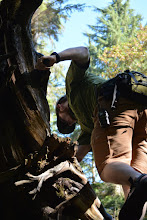Flash

One of the biggest steps you can take to allow yourself a wider range of options photographically is to get an external flash for your camera. Very high-end or prosumer digital cameras will usually allow you to do this (eg: Canon G Series - >$300 used) and I have never seen an SLR or DSLR that doesn't at least have a hotshoe. High-end SLRs will have a PC Sync port (at right), as well.

External flashes will usually allow you to tilt the flash head itself, which gives you the ability to bounce your flash off of the ceiling or walls. It really helps to alleviate the whole "This is a picture" feeling that direct, on-camera flash (at left) gives. It tends to give much more natural-feeling light due to the fact that we, as humans, are use to light coming from above us. The sun, most room lights, etc, are all above our heads, so we spend our whole lives accustomed to lighting from above. When you take a picture and use the on-camera flash your main light is now on the camera. How often do you have lights behind your retinas? "Retinae"?
 Further, an external flash can be used with all sorts of lighting gear, such as remote triggers, umbrellas, snoots, grids... people... With a flash and a remote trigger (eg: PocketWizard - ~$400/pair), you're able to hand your flash to someone (preferably a friend, so they don't run off with it) and use them as an emergency tripod. This setup is sometimes referred to as using a "Voice Activated Tripod". "Fred, turn left, would you?", and such. You're then much more likely to get what you see at the right.
Further, an external flash can be used with all sorts of lighting gear, such as remote triggers, umbrellas, snoots, grids... people... With a flash and a remote trigger (eg: PocketWizard - ~$400/pair), you're able to hand your flash to someone (preferably a friend, so they don't run off with it) and use them as an emergency tripod. This setup is sometimes referred to as using a "Voice Activated Tripod". "Fred, turn left, would you?", and such. You're then much more likely to get what you see at the right.
And then there's the downside to doing all of this on the cheap: it's all manual. You're not using any i-TTL, or CLS, or anything like that. You're directly controlling the flash power (Full, 1/2, 1/4, etc) and the exposure. You can leave the exposure on auto sometimes, but the camera doesn't know what the flash is doing, so it usually won't work right.
At left is an example why you don't let the camera figure exposure when you use off-camera lighting. There are other and better reasons, but those are a topic for a blog of their own.
Thanks to Kilik for unknowingly providing me with examples.
Labels: photography tips, pictures


1 Comments:
Flashy post, Will.
Post a Comment
<< Home